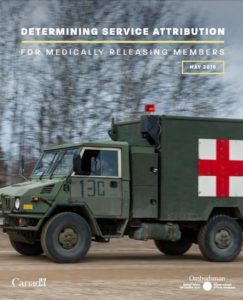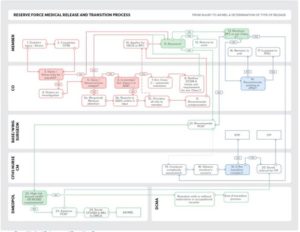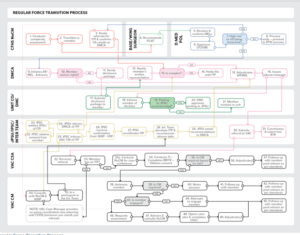Every year more than 1,500 Canadian Armed Forces members are released from the service due to a variety of medical reason. Transitioning into civilian life is not always smooth. However, for many ill or injured CAF members the process means waiting for months to have their benefits applications processed and to receive the services or medical attention they require.
Gary Walbourne, National Defence and CAF Ombudsman, today, released a complicated flow chart which detailed the hurdles that ill and injured solders need to navigate in order to return to civilian life, once they are released from active duty.
(Click on the image below to access full report)
He said the document reveals the “current reality” those released from the service face and why it is critical that the administrative burden be dealt with.
RELATED CONTENT
Veterans losing out due to mismanagement of drug benefits
“Medically releasing from the Canadian Armed Forces is complicated,” Walbourne said in a statement. “The burden has taken its toll on members transitioning from military to civilian life and their families. It is evident that a streamlined process is needed.”
The report released by his office said members and veterans are frustrated by the “heavy administration, the duplication of effort, the lack of clarity, the onus placed on them to gather the proof from CAF for VAC to determine their entitlements,” and the delays in the release of benefits.
Back in May, the office of the Ombudsman had made the recommendation to the Defence Minister that CAF determine whether an illness or injury is caused or aggravated by that member’s military service and that the CAF’s determination be presumed by VAC to be sufficient evidence to support an application for benefits.
In response, Defence Minister Harjit Sajjan wrote in August that while there is merit in the suggestion, the DND and CAF require more time to review the implications.
“Nonetheless, the CAF has no extant statutory or policy mandate to systematically determine if an illness developed or an injury sustained during a member’s career is related to their military service,” Sajjan said in his letter to Walbourne.
He said the government is “looking at a variety of way in which we can better service members through the transition process in order to expedite and simplify their receipt of benefits.”
The report released by the office of the DND-CAF Ombudsman today recommended changes to the following:
New Veterans Charter (NVC) Benefits and Eligibility
The primary source of benefits for currently releasing members is the Canadian Forces Members and Veterans Re-Establishment and Rehabilitation Act (New Veterans’ Charter or NVC). There are various services and benefits available under the NVC, each having distinct eligibility criteria.
Some of these benefits and services are available to any medically releasing member or to members who have not been released for medical reasons provided they can demonstrate that they have a disability resulting from an illness or injury that is attributable to service.
Most of the remaining benefits require applicants, regardless of release category, to demonstrate three things: (1) that they have an illness or injury; (2) that the illness or injury was attributable to service; and (3) that they have a certain degree of disability resulting from the illness or injury.
The term “attributable to service” is used to indicate that an injury or illness is directly caused or aggravated by military service.
Recommendation:
The CAF should determine whether an illness or injury is caused or aggravated by that member’s military service and that the CAF’s determination be presumed by VAC to be sufficient evidence to support an application for benefits.
“This recommendation fits within the existing legislative framework but requires a willingness to rethink the status quo,” the Ombudsman’s report said.
NVC and the Current Service Delivery Model
The NVC stipulates that the Minister of Veterans Affairs, may, on application, pay an award or benefit if the applicant establishes an injury or illness that is attributable to military service.
More specifically, the onus is on the applicant to provide evidence of (1) a diagnosed condition, (2) that it is attributable to service, and that (3) there is a resulting disability.
In determining whether the evidence provided by the applicant meets the eligibility criteria, Veterans Affairs Canada (VAC), as the administrator, considers mostly documentary evidence generated by the CAF. The evidence consists largely of the applicant’s medical records and possibly other career related records.
Recommendation:
CAF should determine whether a member’s condition is related to or aggravated by military service rather than requiring a long bureaucratic process for VAC to review the records prepared by CAF. It is possible already for CAF to make such determination since the CAF has control of the member’s career and has responsibility for the member’s medical health throughout that career.
“Common sense suggests that CAF is best placed to know whether a member’s physical or mental health condition is caused or aggravated by their military service,” the report said.
The report said these recommendations will likely face some resistance “by those who are entrenched in the existing administrative process or service delivery model.”
“However, the model is broken as is evident from the plentiful media reports and the embarrassing statistics of service,” according to the report. “It is also very unfair to the medically releasing CAF member.”





Comments are closed.